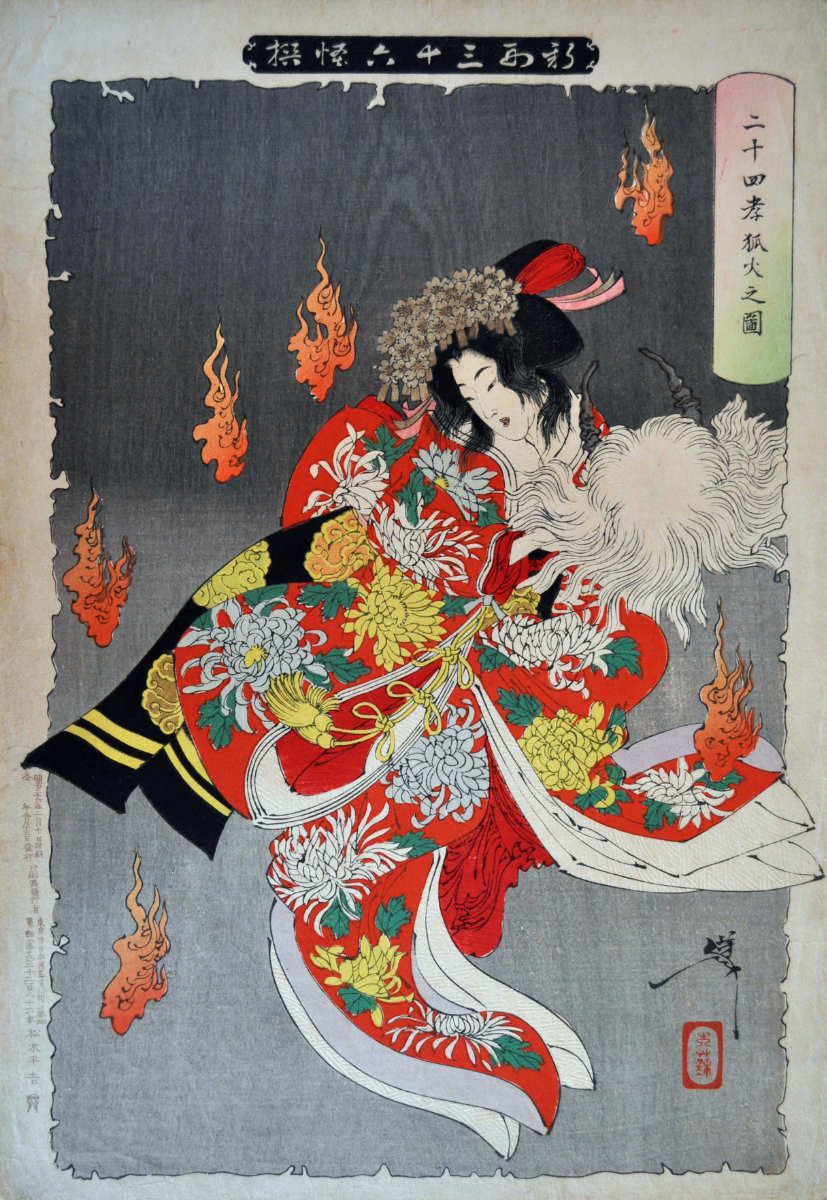In the play Honcho Nijushiko, or Twenty-four Examples of Filial Piety (1766), “Princess Yaegaki learned of her lover’s danger but was prevented from warning him by an icy lake outside her father’s castle that she was afraid to cross. She prayed to the god of the Suwa shrine, who sent a white fox to protect her. Here in the print we see the princess carrying the horned helmet, decorated with flowing white hair, as she follows the magical foxfires across the frozen lake. Her furious dance as she is possessed by the fox spirit is the climax of both Bunruka and Kabuki performances. The princess’s robes are embroidered with chrysanthemums, an imperial motif, and she wears an ornate headdress of artficial silver flowers. The gray background is enlivened by the grain in the cherry-wood printing block. Flames floating in the air are a convention denoting the presence of the supernatural.” From Yoshitoshi’s Thirty-Six Ghosts (1983) by John Stevenson.
| Alias Foxfire |
| Real Names/Alt Names ○ |
| Characteristics Myths & Legends, Yokai, Medieval Age, Japanese |
| Creators/Key Contributors Tsukioka Yoshitoshi, ○ |
| First Appearance Japanese folklore |
| First Publisher ○ |
| Appearance List Konjaku Monogatarishū (12th century), Uji Shūi Monogatari (early 13th century), Shokoku Hyakumonogatari (1677) by Asai Ryōi, Otogi Bunko (late 17th century, Edo period chapbook collection), the play Honcho Nijushiko (Twenty-four Examples of Filial Piety, 1766), Konjaku Gazu Zoku Hyakki (1779) by Toriyama Sekien, Gazu Hyakki Tsurezure Bukuro (1781) by Toriyama Sekien, Shinpen Musashi Fudoki Kō (1811) by Saitō Gesshin, Ehon Hyaku Monogatari (1841) by Takehara Shunsen, One Hundred Famous Views of Edo: The Foxfires at the Changing Tree, Ōji (1857) by Utagawa Hiroshige, Foxfire and the Transformation of the Old Woman (early 19th century) by Utagawa Kuniyoshi, Kitsunebi at Ōji (various late Edo depictions by Hiroshige school), Kitsune no Yomeiri (The Fox Wedding) (19th century) by Utagawa Kunisada — often depicted foxfires accompanying fox spirits in procession. |
| Sample Read Tsukioka Yoshitoshi Archive at Ronin Gallery [Ronin Gallery] |
| Description In the play Honcho Nijushiko, or Twenty-four Examples of Filial Piety (1766), “Princess Yaegaki learned of her lover’s danger but was prevented from warning him by an icy lake outside her father’s castle that she was afraid to cross. She prayed to the god of the Suwa shrine, who sent a white fox to protect her. Here in the print we see the princess carrying the horned helmet, decorated with flowing white hair, as she follows the magical foxfires across the frozen lake. Her furious dance as she is possessed by the fox spirit is the climax of both Bunruka and Kabuki performances. The princess’s robes are embroidered with chrysanthemums, an imperial motif, and she wears an ornate headdress of artficial silver flowers. The gray background is enlivened by the grain in the cherry-wood printing block. Flames floating in the air are a convention denoting the presence of the supernatural.” From Yoshitoshi’s Thirty-Six Ghosts (1983) by John Stevenson. |
| Source ○ |

